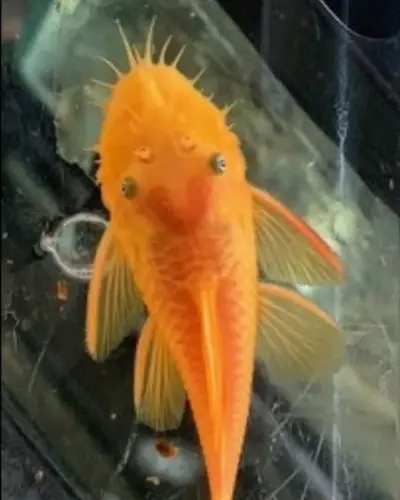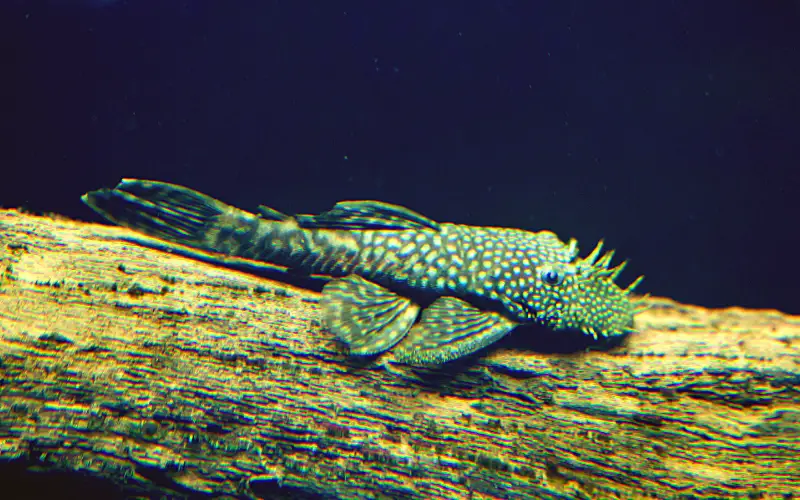Have you ever wondered just how long a Bristlenose Pleco can live in your aquarium? Known for their unique appearance and incredible algae-cleaning abilities, these fascinating fish are a favorite among aquarists. But understanding the Bristlenose Pleco lifespan is key to providing the proper care they need.
Whether you’re a seasoned fishkeeper or just starting, ensuring their longevity requires attention to a few critical factors.
With optimal care, a Bristlenose Pleco can enjoy a long life, potentially reaching up to 12 years in a home tank.
However, their lifespan is closely tied to the quality of care they receive. From maintaining a clean environment to providing the right diet and tank mates, every detail matters.

Bristlenose plecos are popular freshwater aquarium fish, known for their bristly appearance and beneficial algae-eating habits. Understanding their lifespan and care requirements can greatly enhance your experience as an aquarium keeper.
In this post, we’ll dive into the essential tips for maximizing the lifespan of your Bristlenose Pleco, helping you keep these amazing fish healthy and thriving for years to come.
Let’s explore what it takes to become an expert in Bristlenose Pleco care!
Table of Contents
ToggleBristlenose Pleco Lifespan in a Tank
How long do bristlenose plecos live in captivity? The lifespan of bristlenose plecos typically ranges from 5 to 10 years in a well-maintained aquarium. Factors such as tank size, water quality, and diet play crucial roles in determining how long do bristlenose plecos live.
In larger tanks with stable conditions, these fish may even thrive beyond the average lifespan. Regular water changes, appropriate filtration, and a balanced diet, including high-quality algae wafers, can significantly contribute to their longevity.

Moreover, bristlenose plecos prefer environments that mimic their natural habitat. This includes having plenty of hiding spots created by driftwood, rocks, and live plants.
By providing an ideal living space, you not only enhance their comfort but also promote healthier growth. A peaceful aquarium environment free from aggressive tank mates further ensures that these peaceful creatures can live a longer, more fulfilling life.
What is the Maximum Lifespan of Bristlenose Plecos
The maximum lifespan of bristlenose plecos can reach up to 15 years in captivity under optimal conditions. While most aquarium enthusiasts will find their plecos living for around 5 to 10 years, exceptional care can lead to longer lives.
Factors such as genetics, tank size, and diet heavily influence this aspect. For instance, albino bristlenose plecos and super red bristlenose plecos may exhibit different lifespans, influenced by their specific care requirements.
Furthermore, selecting healthy fish from reputable sources can set the foundation for a longer lifespan. New owners should be aware of the signs of a healthy pleco, including clear eyes, active swimming behavior, and a well-formed body.
Regular monitoring of water parameters and providing a varied diet can also aid in achieving the maximum lifespan, ensuring that your bristlenose catfish enjoy a long life free from common aquarium ailments.
Why Are My Bristlenose Plecos Dying?
Understanding why your Bristlenose Plecos are dying can be challenging, especially since these fish are known for their hardiness.
To create a suitable environment for them, it’s essential to ensure that you replicate their natural habitat. This includes maintaining proper water quality, as well as keeping the ph range slightly acidic, ideally between 6.5 and 7.5. High nitrite levels can be detrimental to their health, so regular testing is crucial.
Additionally, providing ample space to swim is vital, particularly as these fish can grow significantly. A tank of at least 20 gallons is recommended, especially if you have other species like rasboras or corydoras.
Their diet should consist mainly of herbivorous fish food, such as crushed flakes and protein-rich foods. It’s also important to feed them small amounts to avoid overfeeding.
Lastly, observe their physical characteristics; the flattened body and flowing fins are prominent in males, and variations in colors and patterns can indicate stress or illness. If your Ancistrus are showing signs of distress, revisiting their care parameters could prevent further losses.
Tank Mates for Bristlenose Plecos
Choosing appropriate tank mates for bushynose plecos is crucial for maintaining harmony in the aquarium.
Generally, bristlenose plecos are peaceful and can coexist with many fish species. Ideal companions include tetras, guppies, and other small, non-aggressive fish. However, it’s important to avoid larger or territorial species that may stress or harm your bristlenose catfish.
When setting up an aquarium, consider the tank size and ensure it’s spacious enough to accommodate all inhabitants comfortably. Male and female bristlenose plecos can also live together, but it’s advisable to have more females than males to reduce aggression during breeding periods.
Overall, an understanding of the social dynamics and behavior of potential tank mates for bristlenose catfish is essential in creating a peaceful aquatic environment.
Breeding Bristlenose Plecos
Breeding bristlenose catfish can be a rewarding experience for aquarium enthusiasts. To successfully breed these fish, it is essential to create the right conditions in the tank.
This includes providing adequate hiding spots where females can lay their eggs and males can guard them afterward. Male bristlenose plecos are known to take on a protective role, fanning the eggs to ensure optimal oxygen flow.
In addition to creating an ideal breeding environment, maintaining stable water conditions is vital. A gradual increase in water temperature can trigger breeding behavior.
After successful fertilization, female bristlenose plecos will lay clutches of eggs, typically ranging from 30 to 100. Once the eggs hatch, it is crucial to provide high-quality food for the fry, ensuring they grow healthy and robust in their new environment.
How Big Do Bristlenose Plecos Get?
Bushynose plecos, part of the loricariidae family, typically grow to around 4-6 inches in length. These hardy fish are often available in various colors, including brown or black, and they develop prominent bristles, especially in males.
For both beginner and experienced fish keepers, it’s essential to provide a suitable tank that mimics their natural habitat found in rivers and streams.
A larger aquarium allows for better water quality, which is crucial for their health. A good rule of thumb is to avoid overfeeding them, as this can lead to problems like white spot disease or ich. Instead, offering a diet of spirulina wafers and other suitable foods will ensure they thrive.
During breeding, these fish are known to lay eggs and fry, which requires careful attention to water quality and tank conditions. Especially during breeding, maintaining a proper filtration system is vital to replicate their natural environment.
By ensuring these conditions are met, fish such as tetras can coexist harmoniously with Bristlenose Plecos, creating a vibrant and balanced aquatic ecosystem.
Key Takeaways on How Long Do Bristlenose Plecos Live
In summary, the lifespan of bristlenose plecos is influenced by various factors, including tank size, water quality, and diet. Owners should strive to create a suitable habitat that meets the needs of these remarkable fish.
The average lifespan is around 5 to 10 years, but with the right care, it can extend up to 15 years. Understanding the conditions that affect how long do plecos live is essential for successful aquarium keeping.
Additionally, selecting appropriate tank mates and ensuring a stress-free environment are key to promoting longevity.
Regular maintenance of the aquarium and providing a nutritious diet are fundamental practices every aquarium keeper should adhere to. By focusing on these aspects, you can significantly enhance the quality of life and lifespan of your plecos.
Frequently Asked Questions about the Lifespan of Bristlenose Pleco (FAQs)
What is the average lifespan of a bristlenose pleco?
Bristlenose plecos can live anywhere from 5 to 10 years with proper care, making them a popular choice among aquarium enthusiasts.
Are bristlenose plecos good for beginners?
Yes, bristlenose catfish plecos are relatively easy to care for, making them an excellent option for new aquarists.
What are some common types of bristlenose plecos available in the aquarium trade?
Common types include the super red bristlenose pleco, albino bristlenose pleco, longfin bristlenose pleco, starlight bristlenose pleco, and calico bristlenose.
Do Bristlenose plecos require special tank conditions?
Yes, bristlenose catfish prefer a pH level between 6.5 and 7.5 and thrive in clean, well-maintained water to avoid poor water quality.
How do bristlenose plecos help keep the tank clean?
Bristlenose catfish species are excellent algae eaters and will consume excess algae, helping to maintain a clean tank environment.
What do I need to provide for my bristlenose pleco to thrive?
To ensure proper care, provide plenty of hiding places, such as caves or driftwood, and maintain a stable water temperature and quality.
Can bristlenose plecos be kept with other fish?
Yes, bristlenose plecos are generally peaceful fish and can be kept with many other fish species. Suitable mates for bristlenose plecos include other peaceful freshwater fish.
What should I feed my bristlenose pleco?
Bushynose plecos primarily eat algae but should also be fed a varied diet that includes sinking pellets, vegetable matter, and occasional protein sources.
Are longfin bristlenose plecos different from common plecos?
Yes, longfin bristlenose plecos have longer fins compared to standard plecos, making them visually distinct while sharing similar care requirements.
What is the Maximum albino Bristlenose pleco lifespan in community tanks?
The maximum albino longfin bristlenose pleco lifespan in an aquarium is typically 10 to 15 years, with proper care and optimal water conditions contributing to their longevity.
Are bristlenose plecos herbivores?
Bristlenose plecos are primarily herbivores, feeding on algae, plant matter, and vegetables. A balanced diet also includes some protein sources to ensure their overall health and well-being.
Where do Bristlenose plecos come from?
Bristlenose plecos originate from the Amazon Basin in South America, thriving in freshwater rivers and streams with plenty of vegetation and hiding spots for protection.
Final Thoughts
In conclusion, bristlenose catfish species are exceptional fish that can add beauty and functionality to any aquarium. Understanding their lifespan and care requirements is essential for ensuring they thrive in your tank. By implementing the tips discussed, such as appropriate tank mates, breeding considerations, and maintaining optimal water conditions, you can enjoy the delightful presence of bristlenose plecos for many years.
Moreover, as you embark on this journey of caring for bushynose plecos, remember to monitor their health regularly and adapt to any changes in their environment. With dedication and attention, you’ll be rewarded with the sight of these algae-eating wonders flourishing in your aquarium, enriching your aquatic experience immensely.
You might also like
- Bristlenose catfish Species Profile: (A Comprehensive Guide)
- Bushynose Pleco Size: A Comprehensive Beginners Guide!
- Ultimate Rubber Lipped Pleco Care Guide: Price, Size & More
- Super Red Bristle nose Pleco 101 – A Comprehensive Guide
- Bristlenose Catfish Tank Size: 3 Huge Mistakes You’re Making!
- Green Phantom Pleco Breeding – A Comprehensive Guide
- Pleco Albino Bristlenose: a Comprehensive Beginner Guide




